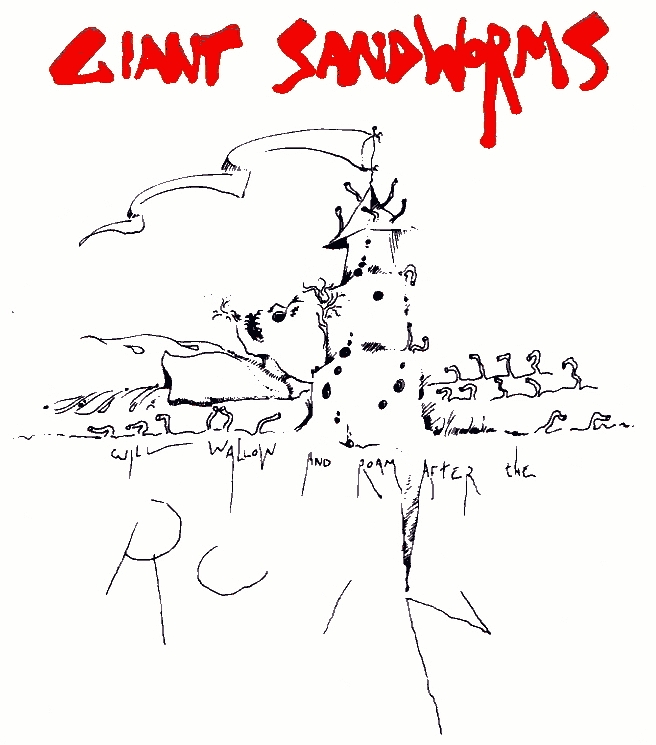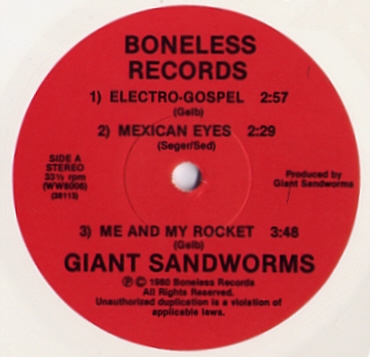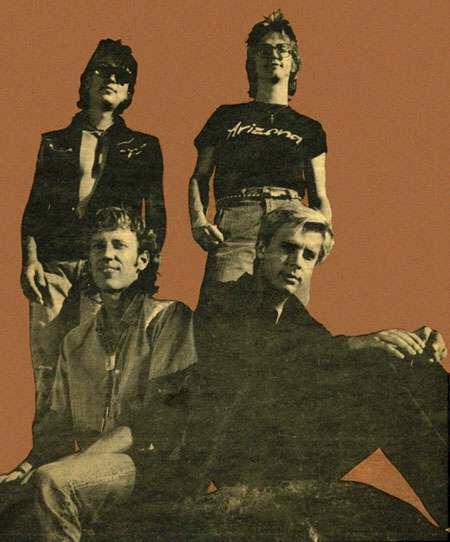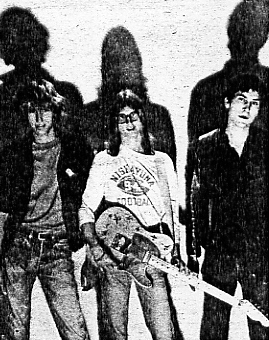|
Giant
Sandworms: Desert Sophistication
By Constance Commonplace
July 15-August 12, 1983
It’s summer. The heat of the day can be assessed before ever
opening a blind in the morning by sensing the quiet of the outdoors.
A silence, broken only by the mating songs of the cicadas whose life
span is so short they can’t afford the luxury of waiting ‘til
the sun goes down. ‘Yeah, but it’s a dry heat,’ is a true
enough statement to an east coaster used to the moisture
making-humidity. But, no matter how dry, at 101 degrees Tucsonans
still sweat. We may moan about the cultural drought existing in our
environment as our energy is being zapped by the sun– yet, we
stay. So why are we here? There seems to be an attraction about
Tucson that seeps in and never quite leaves the bloodstream. Perhaps
it’s a matter of learning to survive on so little– like the
saguaro growing in grains of intensely hot sand, getting minimal
amounts of water yet greening and stretching their arms toward the
sun. It is not all so bleak as we sip margaritas and tequila
relaxing in our cultivated mañana attitudes or experiencing the
wonder of a desert night with gnomes and UFOs dancing in the
silhouette of mountains under spectacularly starry skies. Tucson is
a healthy incubating environment that allows us to stretch out and
take risks. We are surrounded by an inexplicable energy that somehow
nourishes the spirit– something magically magnetic that keeps
sucking us back from wherever it is we go when we say we’re
finally getting out of this bloody town. Ask the Sandworms– for it
is from this Sonoran desert that the Giant Sandworms were spawned
and ran from only to return. It has been three years this August
(1983) since Rainer Ptacek invited his friend Howe Gelb to return to
the desert and make music. “My first picture of the city’s music
scene was in June (1980). The Pills were playing on a Monday night
and I went down with Rainer to see what was going on. We had left
and come back as everybody was leaving the place. This car rolls
around, does a u-turn and a guy gets out of the back rear window
with a semiautomatic and starts opening up on the crowd. It was then
we knew that people weren’t happy with what was going on and
needed something new,” wryly recalls Gelb. A few days later,
drummer Billy Sed went to Howe and Rainer for a jam bringing
guitarist David Seger along. Seger and Sed had been playing together
for six years in this desert town. They tried to loosen up with the
old standard, “Louie, Louie,” and just couldn’t do it. The
next attempt was “Me and My Rocker” which “was awful, but
there was a magic there.” The band (which was not yet the
Sandworms) definitely had some beginning of a ‘sound’ yet was
rather amorphous. Rainer’s influence was felt in the rhythm and
blues aura conveyed in some of the covers played by the band. There
was no one arranger for the music. “Somebody would say what flavor
they thought they wanted, but everyone would interpret that flavor
differently,” explained Howe. Somewhere along the way Rainer left
the band and the remaining trio decided to make the musical move to
New York. “We wanted to see what was going on,” cites Howe,
“which meant leaving the desert, making us very sad.” The
cross-country trip was “wild” by their own description
communicating via walkie-talkies and running out of money and gas.
Settling in a rural New Jersey town close to the city limits, they
practiced in what was once the lion house of the Ringling
Brothers/Barnum and Bailey circus. The owner turned-out to be a bit
of a maniac– “he had a nasty habit of shooting at werewolves and
vampires in his house”– the Worms made the city move. Dredging
through New York’s outrageously priced apartments for two weeks
while crashing on various friends’ floors they met Larry, a
red-haired Irishman who said with a bit of a brogue, “It’s a
great little place, you guys.” In a recent Rolling Stone article,
reference was made to Toilet, a renowned scoring place on the Lower
East Side. It was in a cubbyhole occupying the fifth floor of this
building on Avenue B that the Sandworms called home. Once settled,
they immediately began hitting the clubs and tried to find a place
to play music. Appropriately enough, they connect with a Mexican man
who rented practice space for a fee that seemed to vary with his
mood but averaging about ten dollars an hour. Many of the popular
neighborhood bands played there– popularity being determined by
neighborhood demand and the amount of time put into the music. The
Sandworms were not a popular band but began accumulating the
necessary hours to become contenders for the coveted title of best
band on Avenue B. Dropping off tapes and making continuous club cans
consumed much of their time. Meanwhile... Scott Garber, who
currently plays bass with the Giant Sandworms, was not a Toilet
resident (didn’t even know the Sandworms existed), was doing the
same dance with a more visually oriented beat. A landscape
photographer from Rochester, New York, Garber was in the city
hustling his portfolio around art galleries. Seems the thing was
more S&M oriented. Success was contingent on who you knew and
Garber never met the right ones. He wanted to photograph…the
desert. So, Scott ran to the desert while the trio of Sandworms were
running around the city he was running from. The Sandworms played a
few of the lesser known clubs and were told they had a “western
sound,” a definition they never quite understood. The first time
they played “Mad City” (a popular Sandworm song) in CBGBs the
person at the board added echoes on the drum and vocals– it was a
major awakening of what Sandworm music could become. They
experienced an incredible high and felt that the dream freeway may
be clearing a lane for them. Rainer Ptacek passed away on November
17, 1997 from a brain tumor discovered in early 1996. He was born on
June 7, 1951 in East Berlin. Reality and time tends to pale
the techno-color quality of dreams and after months of slum
living– the dream was over. Howe was in Atlantic City gambling,
David was an x-ray technician in Jersey, and Billy was doing the
city slide of trying to get by. At their various locations they
learned they were booked at CBGB’s for that night. Howe who was
the farthest away arrived first with ten minutes before they were
due on stage. Mishaps and breakdowns had to be dealt with and while
they were setting up, Billy and David were ragging at each other. It
was not a great gig. Though they persevered through the sequence of
obstacles– the Giant Sandworms heard the call of the desert. David
and Billy left the city slums and saw saguaros forty-two hours
later. Howe stayed a bit longer selling Indian artifacts and pots in
an American Indian art gallery and met someone who had connections
at Trax– a coveted club date– but it was too late. Truly, it was
a matter of just not the right time for Sandworm success. Back
in the desert the guys took a summer sabbatical ... from each other.
The city scene had frayed some wires weakening the connections. Howe
played with Ned Sutton in the Black Hills (South Dakota). Billy and
David continued to play together. Around July, Scott was introduced
to David and the three began jamming on a regular basis. He was
interested in joining the band as bassist that would allow David to
get back to his preferred guitar. The only thing left was to talk to
Howe about it when he returned from playing with Ned. “I remember
the first time I met Howe,” Scott conveys, “It was like the
decision had come into town.” Scott became a Sandworm.
Retrospectively, Howe feels the effects of the city on their music,
“exorcised all of our demons toward each other and because of that
we can perform and create together a lot better.” The music that
left the desert had become sophisticated, with crisp edges and a
city strut enriched by a fourth member. Scott holds down the
backbeat freeing Howe to interact with David and to play his
keyboard more often. The band’s original music has no real game
plan. Each tune has a structure that each member builds his own
sound around: Howe, the great experimenter; shy David, popster who
lets his lyrics convey his message; Euro-techno is Scott’s
addition; and Billy is Mr. Soul himself. The idea of an identity
caused a bit of discussion as they felt they don’t have one. Scott
felt that the urban experience has been ingrained in their music,
“the whole idea of cacophony, of everything happening at once is
very much like the way the city is. For every city block there are
at least five stories going on; someone trying to pick your pocket,
people in business suits and folks with no arms or legs– all
aspects of life occurring at the same time.” There have been four
stages of evolution since the inception of the band and with Scott
having been with the band for almost a year, Gelb feels they are
moving into a fifth. No matter what phase of progression, the Giant
Sandworms is one of the most exciting bands around. Each performance
is fresh because they are free to interpret the song for that moment
and the delivery conveys commitment to their craft. A Giant
Sandworm’s gig leaves you dripping with dance sweat and the
satisfaction of being able to say, “I can feel the passion" |




